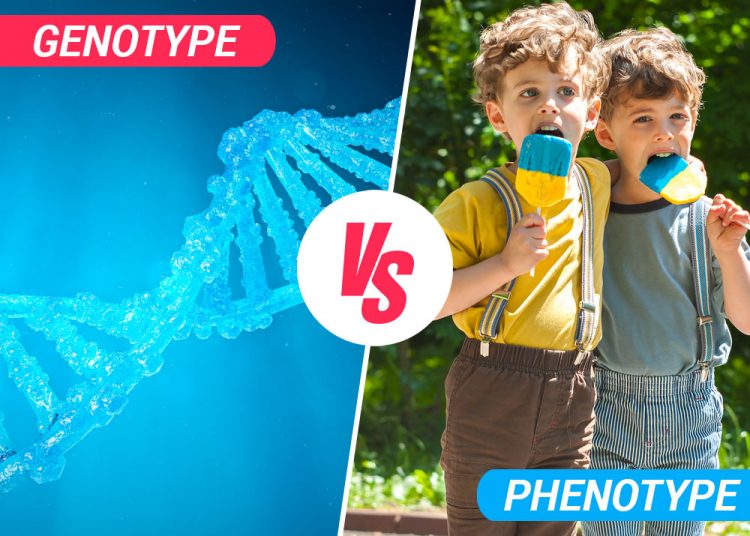With rising interest in alternative health and epigenetics, terms like phenotype and genotype continue to become more and more mainstream.
But are you sure which is which, and how to use them?
These technical terms can be confusing. While they’re both used in the context of human biology, they actually refer to different parts of our genetic make-up.
Let’s unravel our complicated genetic code for a minute and do a deep dive into what makes you you.
Phenotype vs genotype – definition
While it can be easy for some to throw around scientific terms occasionally, it’s not so easy to define them accurately.
Before we look at how exactly our phenotype and genotype shape who we are, it’s important to clarify what precisely these words mean.
Genotype
We’re all made from the basic building blocks of our DNA (a complex set of genes passed on by our parents).
While people generally have a significant amount of DNA in common with one another (simply because we’re all human), sections of DNA vary from individual to individual.
That’s why some of us are athletes, and some of us are physicists. Some love chocolate; others loathe the taste. The entire human tapestry is richly different with almost infinite variation.
You are truly an individual. And that’s down to your genotype – the unique set of genes that went into making you who you are.
Your genotype is your individual set of genes. If you were a computer, your genotype would be the code to your operating system. It’s the foundation of everything you are, which is why it’s such a biological big deal.
Your genotype is inherited from your parents, and it’s fixed from birth. Whatever’s in that genetic coding is there to stay and isn’t influenced by external factors. How this manifests as you age, however, strays into the territory of phenotypes.
Phenotype
So far, so good. But where does your phenotype come in?
Your phenotype is simply the expression of your genotype. To use the computer analogy again, the genotype is the code, but the phenotype shows whether you’re running Windows 95 or Mac OS.
We may not be able to see our genotype, but we can certainly see our phenotype in attributes like hair color, strength, height, and other noticeable characteristics.
Unlike your genotype, your phenotype is alterable. It can be tweaked by your environment and lifestyle choices.
For example, you may have the genotype for weight gain, but you won’t pile on the pounds if you follow a strict diet.
You also could be predisposed to a certain disease, like Parkinson’s, but that doesn’t mean you’ll necessarily get Parkinson’s.
This is why identical twins aren’t actually identical. They may share a genotype, but that doesn’t necessarily mean they’ll develop the same phenotypes.
Did you know that twins have different fingerprints? This is because your fingerprints develop in the womb and are influenced by factors like temperature and fetal positioning.
Examples of phenotypes and genotypes
It can certainly be difficult to keep phenotypes and genotypes straight if you’re new to the terms. And, to make things more complicated, a genotype can also be a phenotype.
But, before we get to that, let’s look at a few examples to further clarify the two:
- If you carry the genetic markers for diabetes, you have the genotype for that disease
- If you are an extrovert by nature, your gregariousness is your behavioral phenotype
When it comes to the inherited physical characteristics, genotypes can also be phenotypes. For example:
- You have red hair, and your parents have red hair. You inherited that from them in your genotype but, because it’s expressed as a physical trait, it’s also your phenotype.
How to remember the difference between phenotype and genotype
Struggling to remember which is which? Here’s a simple word game that will help you remember the difference between genotype and phenotype.
Hopefully, these easy linguistic tips will help jog your memory when you get stuck:
- Genotype refers to a set of genes. This one’s easy because the word ‘gene’ actually appears in genotype (although only in its pronunciation, not the spelling!)
- Phenotype refers to a set of characteristics. These can be personality traits or physical features. Personality, physical, and phenotype all begin with the letter P, which is a nice bit of consistency worth trying to remember.
Phenotype vs genotype – final thoughts
Humans are complicated, messy creatures, so it’s not easy boiling us down to a few basic biological terms.
The above is definitely a simplified explanation of two tricky concepts, but hopefully, it’s helped increase your knowledge and further your understanding of what genotypes and phenotypes actually mean.
Next time you’re with your family, take a look around. Your younger brother and your mom might share the same shade of brown eyes (their genotype). Your sister might be a great musician, but you may not be able to personally carry a note (your phenotypes). Your father might be tall like you (a genotype expressed as a phenotype).
We’re all different, with varying phenotypes, yet there are many common genotypes at work. That’s just the weird and wonderful world of biology!






